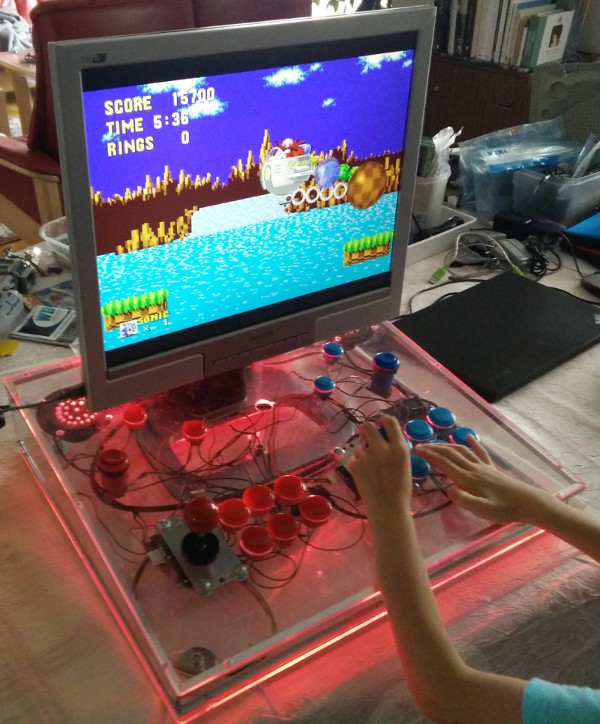-
Bartop with acrylic glass
08/16/2017 at 16:46 • 0 comments -
Overclocking the Pi
12/17/2016 at 15:08 • 0 commentsSome games on MAME and N64 emulators are lagging so I installed a heat sink and a fan (recovered from an used laptop) and overclocked a little bit the Pi 3 following that guide.
Emulators are now running a a little bit more smoothly (some PSP / PSX games are not playable thought).
With the fan, SOC (overclocked) temperature is around 50 ° C.
-
3rd bartop built
12/04/2016 at 20:36 • 0 commentsI just finished my 3rd bartop (and I think last). Build went smoothly (no joystick or screen problem like on the previous one).
I added some LED lights at the bottom to make it cool.
-
2 Xin-mo joystick problem...
10/31/2016 at 16:16 • 0 commentsLike a lot of people, I had trouble using 2 Xin-Mo joysticks on my second arcade station. It was like both were the same joystick.
It’s really strange since the first one didn’t had that problem and it seems that components are the same. I even dump the SD card from one Raspberry Pi to another without success (same problem on the second arcade station, running a Raspberry Pi 3).Solution found on Retropie-setup about Xin Mo Controller didn’t work for me.
So, I finally connect one controller directly to Pi GPIO, like explained on post "Connecting Arcade Buttons to Raspberry Pi GPIO Pins" or on "Retro Gaming with Raspberry Pi".
You’ll have to clone Adafruit-Retrogame, configure /boot/retrogame.cfg file, add a udev rule and launch retrogame at startup.
Also, default mapping for select button (space) causes some problem in game (emulator running a lot faster). I had to change the default key (space) for 'b' to fix that bug.
Update 15/05/2021 : Got the same problem on new bar top build and fixed it via that method (unplugged the 2nd player side's 4 pin (up, down, left, right) connector and turned it around and plugged it right).
-
Native resolution for 19" screen
10/31/2016 at 16:06 • 0 commentsWhile installing a second station, I had a problem with resolution by default in 800x600 on a 19" screen.
To force native resolution (1280x1024), I had to set in /boot/config.txt the following lines :
hdmi_drive=1 hdmi_group=2 hdmi_mode=35More information can be found here : http://elinux.org/RPiconfig#Video
-
Power supply and Raspberry Pi 3
10/30/2016 at 17:30 • 0 commentsThe 3000 ma 5V power supply is enought to power a Raspberry Pi 2 and the Amplifier Board-PAM8803 using a micro usb Y splitter.
However, if you use a Raspberry Pi 3, it isn’t enough to power both (bad audio quality). You’ll need a dedicated power supply for the amplifier.
 Grégory Paul
Grégory Paul